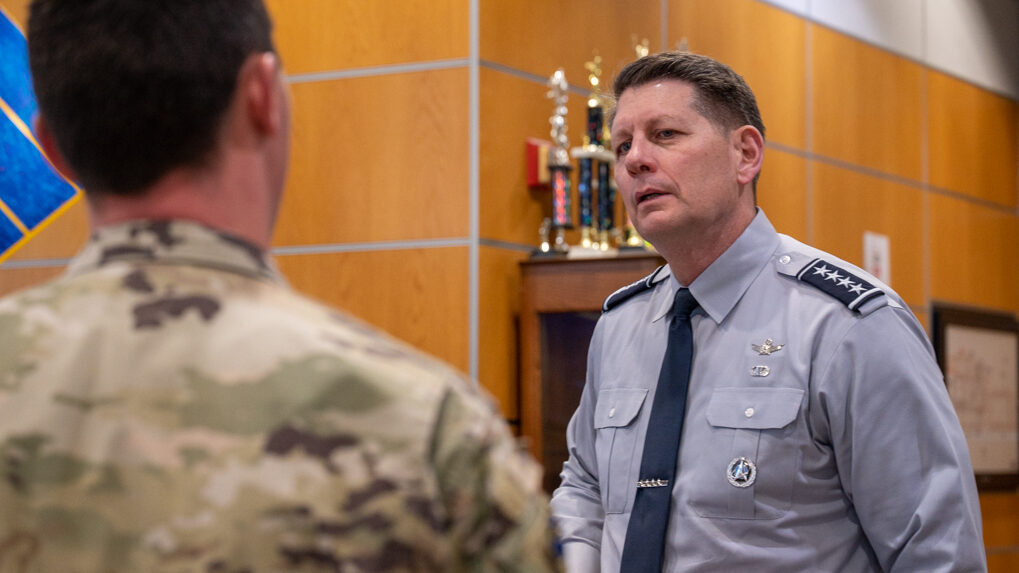
U.S. Space Force Vice Chief of Space Operations Gen. David “DT” Thompson speaks with supervisors and team leads about Guardians at Buckley Space Force Base, Colo., May 12, 2023. (U.S. Space Force photo by Airman 1st Class Shaun Combs)
WASHINGTON — A study commissioned by Defense Secretary Lloyd Austin and Director of National Intelligence Avril Haines on how to separate responsibilities for gathering intelligence, surveillance and reconnaissance (ISR) from space — including sorting out who can task imagery satellites when — is “coming to closure,” according to a top Space Force official.
“The DoD and the DNI, at secretary level, are working through the difference between, let’s call it national reconnaissance/strategic reconnaissance and what warfighters need to prosecute military operations,” Space Force vice chief Gen. D.T. Thompson said today at a Mitchell Institute event.
Further, he said that Chief of Space Operations Gen. Chance Saltzman and National Reconnaissance Office (NRO) Director Chris Scolese are “also working through” how the NRO, responsible for US spy satellites, and the Space Force “work together” to “ensure we’re delivering what combatant commanders need.”
Since the Space Force’s inception three years ago, there’s been some tension between the newest military service and spy satellite agencies over who’s responsible for acquiring satellite imagery and ISR products and providing actionable information to military commanders.
Asked specifically about the question of satellite tasking, Thompson said that while the question has been resolved “at some level,” the final outcome will be determined by the nearly complete study. Both sides, he stressed, “understand very clearly that warfighting systems [are required] to be allocated and controlled through DoD and military processes, and both are fully prepared to do that.”
Thompson explained that NRO is “not just an intelligence organization; they are a DoD organization as well. And I think they fully recognize and understand they have to step up to a new tactical role in that regard. They have demonstrated not just their willingness, but their ability to do so…
“So, I would say they have grown and evolved and recognized, just as well as we have, that they have responsibilities that are not traditional, that are not traditionally focused, and I’m confident that working with them we can meet those needs for timely, direct — not just direct to combatant commands, but in some cases, perhaps direct to weapons when necessary — updates” of ISR imagery, he added.
In addition, Thompson said, said that while the Space Force has a “pilot” on how to buy “commercial space in general,” the service also is “in conversation” with the National Geospatial-Intelligence Agency (NGA) on roles in acquiring commercial ISR for use by commanders in the field.
NGA is charged with prioritizing the dissemination of intelligence gleaned from remote sensing satellites and acquiring commercial ISR analysis. NRO, however, is mandated to buy raw imagery and data from commercial ISR firms — that data is then processed by NGA analysts into action-worthy information for US government offices all the way up to the White House, as well as the military.
“The NGA believes, and has stated very clearly they believe, it’s their responsibility” to be in charge of disseminating commercial ISR, bought via the NRO’s Commercial Systems Program Office, Thompson said, noting that the Space Force is “open” to using NGA’s “means and mechanisms … if they can demonstrate responsiveness and timeliness and meet the combatant commands needs. … We’re more than ready to say that’s the process we’ll use.”
However, Thompson said that if NGA cannot deliver, the Space Force will step in.
“Let me be clear, if in fact, we cannot [rely on NGA], we believe that we are charged and prepared to deliver directly through our own contracting mechanisms and our own means,” he said.
As first reported by Breaking Defense, the Space Force and NRO already have reached an informal accord that would see the service relying on spy sat agency commercial imagery contracts “wherever possible,” and in turn NRO would rely on the Space Force for commercial space data within its acquisition purview, such as space domain awareness data.
Meanwhile, the House Armed Services strategic forces subcommittee in its markup of the annual defense policy bill released today signaled support for both NRO and NGA’s commercial integration efforts. Draft language in the fiscal 2024 National Defense Authorization Act encouraged both to continue to expand those efforts, noting that “the domestic commercial satellite imagery industry continues to develop rapidly with new capabilities available from constellations of satellites dedicated to daily monitoring of the entire planet along with a growing domestic geospatial intelligence analytic industry.”






















